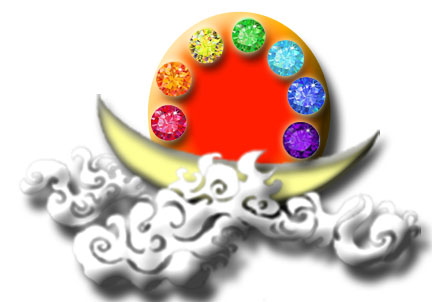
Tashi Tsigpa, meaning eight-fold auspiciousness, consists of verses that bring about auspiciousness by invoking four sets of eight divinities. It is one of the most common prayers said in Bhutan by followers of both Kagyü and Nyingma traditions. The verses were composed in 1896 by the famous Tibetan philosopher and polymath Mipham Namgyel Gyatso (1846-1912). Mipham authored thirty-two enormous volumes of texts on a wide range of topics, though this prayer is arguably the most popular of his compositions. It is a prayer very widely used in the Himalayan Buddhist world when people start a project or a religious practice.
In the colophon, Mipham claims that if one chants the prayer at the start of the day, it will help make the whole day productive and fulfilling; if one chants the prayer when one is going to sleep, it will make the sleep virtuous and stimulate good dreams. If one chants before starting a new project, the project will become a success, and if one chants while going to war, one would come out of it victorious. Chanting this prayer daily is said to bring happiness, prosperity, peace, and fulfilment of all one’s wishes, as well as to eliminate all obstacles, problems, negativities so as to eventually help the person reach enlightenment.
The prayer contains salutations to four sets of divine forces who bestow blessings of auspiciousness and beneficence. The prayer begins with the verse of homage to the Buddhas, dharma and their followers who abide in the auspicious and naturally pure realms in the ten directions. Then, Mipham presents salutations to the eight Sugatas or Buddhas who are particularly known for their blessings of auspiciousness. This part is based on a sūtra in which the historical Buddha Śākyamuni instructs Tsalrab, a young man from the Licchavi clan in Nepal, to remember and recite the names of these eight Buddhas (Tibetan names): Dronmé Gyelpo, Tsalten Döndupgong, Kunla Gongpa Jacher Drakpachen, Jampai Gyenpal, Gewar Drakpa Paldampa, Lhunpo Tarphagpa Tsalrab Drakpai Pal, Semchen Tamché Lagongpa Drakpai Pal and Yidtshim Zepa Tselrab Drakpai Pal.
In the next set, Mipham pays homage to the eight bodhisattvas: Mañjuśrī, Vajrapāni, Avalokiteśvara, Maitreya, Kṣitigarbha, Sarvanivara Navishkambhin (Nivāraṇaviśkambhin), Akaśagarbha and Samantabhadra, who hold in their respective hands a utpala (blue lotus) flower, vajra, white lotus, naga-tree (naga plant,) jewel, moon, and sword, and sun. These great holy beings respectfully personify wisdom, power, compassion, the next Buddha to incarnate in this world, earth store or treasury, eliminator of hindrances, space treasury or void store, and universal virtue.
Mipham then makes salutations to eight female divinities who bring auspiciousness upon merely thinking of them. They are Lāsyā, Mālyā, Gītā, Nirtī, Pūṣpā, Dhupā, Alokā and Gandhā who respectively hold the eight auspicious symbols: an umbrella (supreme parasol), golden fish, wish-fulfilling vase, beautiful kamala (lotus), resounding conch shell, knot of prosperity (marvellous eternal knot), banner of victory, and empowering (all-powerful) wheel.
In the next set, Mipham pays homage to the eight protectors of the world including Mahabrahma (Great Brahmā), Shambu (Śiva), Narayana (Vīṣṇu), Sahasrajna (Indra), and four Guardian (Lokapālas) or Worldly Kings: Dritarāsṭra, Virūḍhaka, Virūpāksa and Vaishravaṇa. The four guardian kings are respectively guardians of the East (white with a pipa or lute and king of the Gandharvas), South (blue with a sword and king of the Kumbhandas), West (red with a snake and king of the Nagas), and North (yellow with an umbrella or stupa and a mongoose and king of the Yaksas).
Mipham concludes the prayer with a verse calling on these divine forces to help overcome all obstacles and harms, fulfil all noble wishes, and help auspiciousness and good marvelous things to prevail.
We chant this every day at the temple either once in English and once in Tibetan or once in English, once in Spanish, and once in Tibetan.
Tashi Tsigpa: The Verses of the Eight Auspicious Ones
OM] Homage to the Buddha, Dharma and Noble Sangha
All that dwell in the auspicious realms of the ten directions,
where all appearance and existence is completely pure.
Their nature is spontaneously perfect. May all be auspicious for us!
The Eight Sugatas (Buddhas)
Tararaja, Sthirakausha Lamadhashaya,
Shri Maitreya Lanka, Shri Varashubhakirti,
Sarva Shayodara Kirtiman,
Shri Sumeru Vadaya Kaushalakirti,
Shri Sarvasattva Shaya Kirti,
and Shri Mantushakara Kushala Kirti.
Prostrations to the Eight Sugatas!
Just hearing your names increases auspiciousness and success!
The Eight Bodhisattvas
Youthful Manjushri, Glorious Vajrapani,
Powerful Avalokiteshvara, Protector Maitreya, Kshitigarbha, Sarvanivara Navishkambhin, Akashagarbha, and the most noble Samantabhadra.
Utpala flower, vajra, white lotus, naga-tree, jewel, moon, sword, and sun!
Supreme in granting auspiciousness and success, gracefully, holding your emblems.
Prostrations to the Eight Bodhisattvas.
The Eight Goddesses of Good Fortune (Auspiciousness)
The most precious umbrella (parasol), the most auspicious golden fishes,
the wish-fulfilling vase of goodness, the exquisite kamala (lotus) flower,
the conch of fame and glory, the glorious knot of prosperity (excellence),
the eternal banner of victory, and the all-powerful wheel.
Holding the Eight Most Precious Emblems, they are the Creators of Delight,
making offerings to the Buddhas of all directions and time.
Just thinking of your essential qualities makes success grow more and more!
Prostrations to the Eight Auspicious Goddesses: Beauty, Garland, Song, Dance,
Flowers, Incense, Light, and Perfume!
The Eight Protectors
Mahabrahma (Great Brahma), Shambu (Shiva), Narayana (Vishnu),
Sahasrajna (Indra). The Four Guardian Kings: Dritirashtra;
Virudhaka; Virupaksha, King of Nagas;
Vaishravana. Each one is holding a divine emblem: Wheel,
trident, dart (lance), vajra,
vina (lute), sword, stupa, and banner of victory!
Auspiciousness and prosperity (righteousness) grow in the three realms!
Prostrations to the Eight Guardians of the World who make this happen.
May the work we are now about to begin meet with ever-growing fulfillment and success.
With all obstacles and harmful influences pacified,
May we achieve good fortune, prosperity,
happiness and peace!
If you recite this when you arise, you will accomplish all your aims for that day.
If you recite it when you go to sleep, you will experience excellent dreams.
If you recite it before you go to war, you will be victorious.
If you recite it when you begin an activity, what you wish for will increase.
If you recite it daily, longevity, glory, fame, prosperity, auspiciousness, happiness and excellence will all be accomplished abundantly in accordance with your wishes.
All harmful actions and obscurations will be purified.
Both the higher realms and the excellent Buddhahood — all aims will be accomplished.
This was said by the Supreme Victor (The Buddha).
— Jamgon Ju Mipham Rinpoche (1846-1912)
Plegaria a Los Ocho Nobles a Auspiciosos Que Traen La Dicha
[OM] Rindo homenaje a todos los Budas, al Dharma y a la Noble Sangha,que residen en los reinos auspiciosos de las diez direcciones,
donde toda apariencia y existencia es completamente pura, natural y espontáneamente perfecta. ¡Pueda todo sernos auspicioso!
Los Ocho Sugatas
Tararaja, Sthirakausha Lamadhashaya, Shri Maitreya Lanka, Shri Varashubhakirti,
Sarva Shayodara Kirtiman, Shri Sumeru Vadaya Kaushalakirti,
Shri Sarvasattva Shaya Kirti,y Shri Mantushakara Kushala Kirti Postraciones a los ocho Sugatas! Tan sólo escuchar sus nombres hace que se incrementen los éxitos y que todo sea auspicioso!
Los Ocho Bodhisattvas
El joven Manjusri, el glorioso Vajrapani, el poderoso Avalokiteshvara, el protector
Maitreya,Kshitigarbha, Sarvanivara Navishkambhim, Akashagarbha
y el mas noble Samantabhadra.
La flor utpala, el vajra, el loto blanco, el árbol-naga, la joya, la luna, la espada y el sol. Son los supremos que conceden éxitos y que todo sea auspicioso,
elegantemente sostienen sus emblemas. Postraciones a los ocho Bodhisattvas.
Las Ocho Diosas de la Buena Fortuna
La sombrilla mas preciosa, los mas auspiciosos peces dorados, el ánfora que colma todos los deseos, la exquisita flor kamala, la caracola de fama y gloria, el glorioso nudo de la prosperidad, la bandera de la eterna victoria y la rueda toda poderosa.
Sostienen los ocho símbolos mas preciosos, son los creadores de dicha,
que hacen ofrendas a los Budas de todas las direcciones y todos los tiempos.
¡Tan sólo pensar de sus cualidades esenciales, hace que el éxito crezca más y más!
Postraciones a las ocho Diosas Auspiciosas, las Diosas de la belleza,
guirnaldas, música, danzas, flores, incienso, luz y perfumes.
Los Ocho Protectores
Mahabrahma, Shambu, Narayana, Sahasrajna, los Cuatro Reyes Guardianes:
Dritirashtra, Virudhaka, Virupaksha el Rey de los Nagas; Vaishravana. Cada uno sostiene un emblema divino: la rueda,
el tridente, el dardo, el vajra, la vina, la espada, la stupa y la bandera de la Victoria!
¡Ellos hacen que lo auspicioso y positivo crezcan en los tres reinos!
Postraciones a los ocho Guardianes del mundo que hacen que esto suceda.
Que la tarea que ahora comenzamos se encuentre con la siempre creciente plenitud y éxito.Una vez pacificados todos los obstáculos e influencias negativas, lograremos buena fortuna, felicidad y paz!
Although you do not need to receive an initiation or be transmitted this chant in its original TIbetan to practice it at the Holy Vajrasana Temple, you may at other temples. We consider chanting it at the temple is your transmission, because you also know the meaning of the chant as you can read it in either English or Spanish. You will find it in Tibetan in the temple’s chant book.
CLICK for Index to all articles on individual English and Spanish Chants. This will be updated as more chants are added to blog.




Add comment